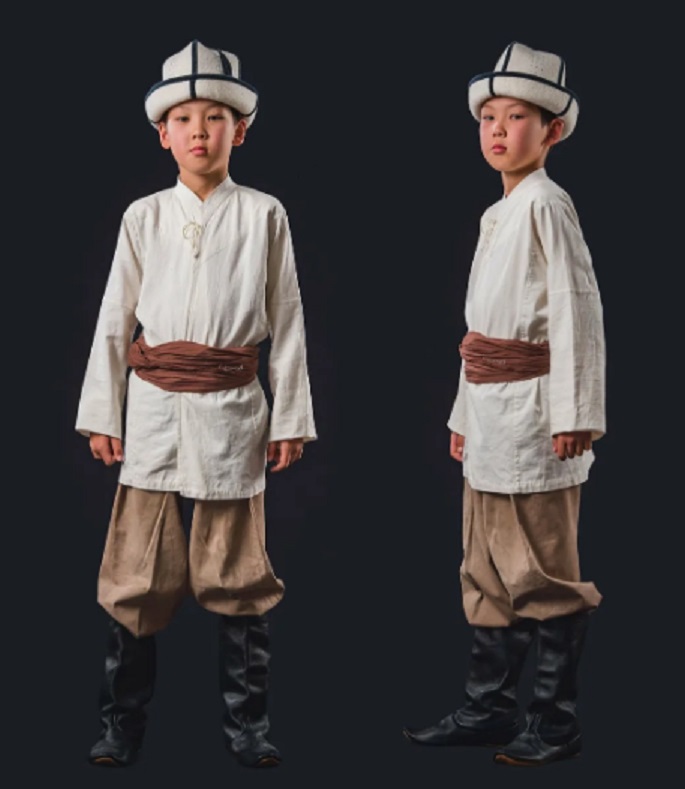
Loop Stitches
The loop stitches ilme, ilmedos, tuura saima, and overlock stitches are considered to be of one type, as each of them is constructed using a loop, arranged and tightened differently.
These stitches are not related to counting; they are embroidered according to a pre-planned pattern; they are ancient and characteristic of Central Asian embroidery.
The "ilme" stitch is widely used among all Kyrgyz, as well as many other peoples, and dates back to ancient times. In the territory of Southern Kyrgyzstan, the "ilme" stitch has been found on items of women's clothing in the Kara-Bulak burial site (Batken region), which archaeologist Yu. M. Baruzdin dates to the early centuries of our era.
The "ilme" stitch is performed by southern Kyrgyz with a needle. Only in the Alai region, as we observed, when embroidering the wall carpet "tush kiyiz," a hook called bigiz is used. Northern Kyrgyz also use a hook for embroidery but call it shibyoge.
When embroidering with a needle, the artisans throw the thread into a loop to the left, pierce the middle of the previous loop with the needle, and direct it towards themselves (see Fig. 60, a). On the reverse side, a line of consecutive stitches is formed, while on the front side, a chain of loops appears. The "ilme" stitch freely conveys any rounded lines of the pattern.
On some items, especially on men's felt "kalpak," and suede trousers, it is customary to embroider a discontinuous chain of one or two loops. This technique is called sekirtme and is evidently ancient.
It is noted in the embroideries found in the Kara-Bulak burial site in the Batken region. The stitch is done discontinuously and in groups of loops in two to three rows (usually with light threads). In this case, the pattern is called kumu reka ('ant').

It adds elegance to the embroidery. The artistic technique of extending the outer loop on sharp protrusions of the pattern is also notable.
With the "ilme" stitch, southern Kyrgyz embroider all kinds of decorations on all materials. It is presented in two variants: as an outline stitch and as a stitch that fills the field of the pattern. When filling the field of the pattern, the stitch is made in several rows, closely adjacent to each other and directed parallel to the contour of the pattern. However, this technique, which is very characteristic of the embroideries of northern Kyrgyz, is predominantly spread in the eastern part of the Osh region and is limited in the western areas of the region (in the past, it was widely used only when embroidering the ear parts of women's headwear).
The "ilmedos" stitch is the most characteristic for the embroideries of southern Kyrgyz. It is common in ancient embroideries and is also found in modern ones. Northern Kyrgyz used it in appliqué in the past. The "ilmedos" stitch is also known to Bashkirs. The ancient origin of this stitch can be judged by the embroidery preserved on fabrics found in Noin-Ula.

The "ilmedos" stitch is performed similarly to the "ilme," but the threads of the loop cover the entire width of the pattern. The artisan catches the fabric with the needle at the edge of the pattern's contour and after tightening the loop, moves the needle across to the opposite edge of the pattern, where the loop is also tightened (see Fig. 60, b, c). A transverse layer of crossing threads appears on the front side. The edges of the stitch naturally have a loop relief. On the reverse side, stitches are located along the contour of the pattern. Some embroiderers call this stitch "tolturma," as it is usually used to fill the field of the pattern after edging (see Fig. 62). It is rarely used without edging (see Fig. 63).
It was used to embroider wrap skirts, wedding gloves, women's sashes, men's suede trousers, as well as decorative items for yurts and horses. This stitch is also known on the "tush kiyiz" carpet and on pillowcases.
The only difference is that the needle is passed each time through a new hole (at the right edge of the previous loop, giving it a rectangular shape) and directed not to the middle of the loop, but to the left edge (see Fig. 60, d).
The execution of the "tuura saima" stitch is very close to the "ilme" stitch.
On the front side, stitches are formed in the form of parallel columns, enclosed between two rows of loop reliefs. On the reverse side, diagonally directed stitches lie.
Sometimes the "tuura saima" stitch is laid in two rows, which gives the embroidery greater appeal.
The same items were embroidered with the "tuura saima" stitch as with the "ilmedos" stitch.
In contrast to the latter, the "tuura saima" has a more limited distribution. It is more often used in the northeastern part of the Osh region (in the Soviet and Uzgen districts). In the southwestern areas of the region, this stitch has not gained popularity.
The overlock stitch is present in ancient Kyrgyz embroideries.
Like the "ilme" stitch, it is ancient and is also noted in the Kara-Bulak burial site in the Batken region. This stitch occurs in two variants: the threads are arranged straight, i.e., at a right angle to the edge (see Fig. 60, e), or diagonally, i.e., inclined to it (see Fig. 60, f).
The stitch has the same arrangement of stitches on both the front and reverse sides. The overlock stitch was more often used to fill the pattern and was found in embroideries without edging.
In modern Kyrgyz embroideries, overlock stitches are rarely used. They are well known to Tajiks and Uzbeks. They are still found in embroideries on Chust-type tubeteikas.
Various Techniques of Kyrgyz Embroiderers













































